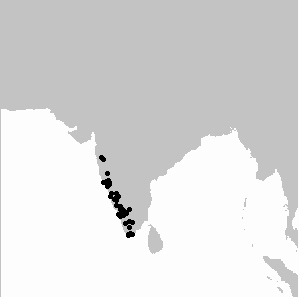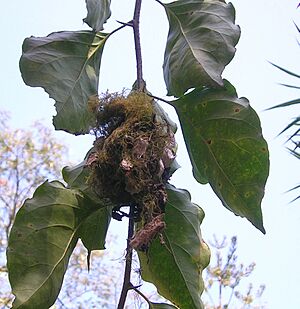Crimson-backed sunbird facts for kids
Quick facts for kids Crimson-backed sunbird |
|
|---|---|
 |
|
| Male in Mangaon, Raigad, Maharashtra |
|
| Conservation status | |
| Scientific classification | |
| Genus: |
Leptocoma
|
| Species: |
minima
|
 |
|
| Synonyms | |
|
Nectarinia minima |
|
The crimson-backed sunbird or small sunbird (Leptocoma minima) is a tiny, colorful bird. It lives only in the Western Ghats mountains of India. Like other sunbirds, they mostly eat nectar from flowers. But they also catch insects, especially to feed their baby birds. These little birds live in forests. They also love gardens at the edge of forests. This is because people often grow many flowers there. They usually sit on a branch while they drink nectar.
What Does the Crimson-backed Sunbird Look Like?
Crimson-backed sunbirds are very small. They are only about 8 centimeters (3 inches) long. They have a thin, curved beak. Their tongue is like a brush and is shaped like a tube. Both of these features help them drink nectar from flowers.
The adult male bird is very colorful. Its back and wing feathers are a velvety red. It also has a wide red band across its chest. The top of its head is a shiny green. There are pink-violet patches on its throat and near its tail. The underside of its body, from the chest down, is yellowish. A black line separates the red chest from the yellow belly. There is another bird, the purple-rumped sunbird, which looks similar. But the crimson-backed sunbird has a darker red on its upper side. Its sides and bottom are also whitish. When the male is not breeding, its colors are duller. Its head becomes more olive-brown. The velvet red is only on its lower back and wings. The female bird is mostly olive-brown. But her rump (near the tail) is clearly red. These birds love gardens with lots of flowers. They are often seen at the edge of forests or farms.
Their calls sound like short chik sounds. They also make longer chee-chee-which-chee sounds.
How They Live and Behave
The crimson-backed sunbird lives only in the Western Ghats of India. It builds nests and raises its young there. The busiest time for nesting is from December to March. However, they can nest almost any month in the southern Western Ghats. They lay two eggs in a hanging nest. The nest is often on a thin branch of a small tree. It can also be on a fern leaf or a bush. Both the male and female help build the nest. The female mostly builds the inside. The female usually sits on the eggs to keep them warm. This is called incubation. The male might help feed the young birds after they hatch. The eggs hatch after about 18 to 19 days.
These birds are very important for some plants. They help to pollinate them. This means they help plants make seeds.
Male sunbirds will protect areas with flowers. They will chase away other birds from their feeding spots. They protect plants with lots of nectar, like Helixanthera intermedia, very strongly.
Because they are so small, insects like praying mantises can sometimes catch and eat them.
These birds usually stay in one area. But they might move to different heights in the mountains. This often happens because of the rain. In some places, they move to lower areas during the monsoon season. Then they move back to higher areas after the rains stop.



